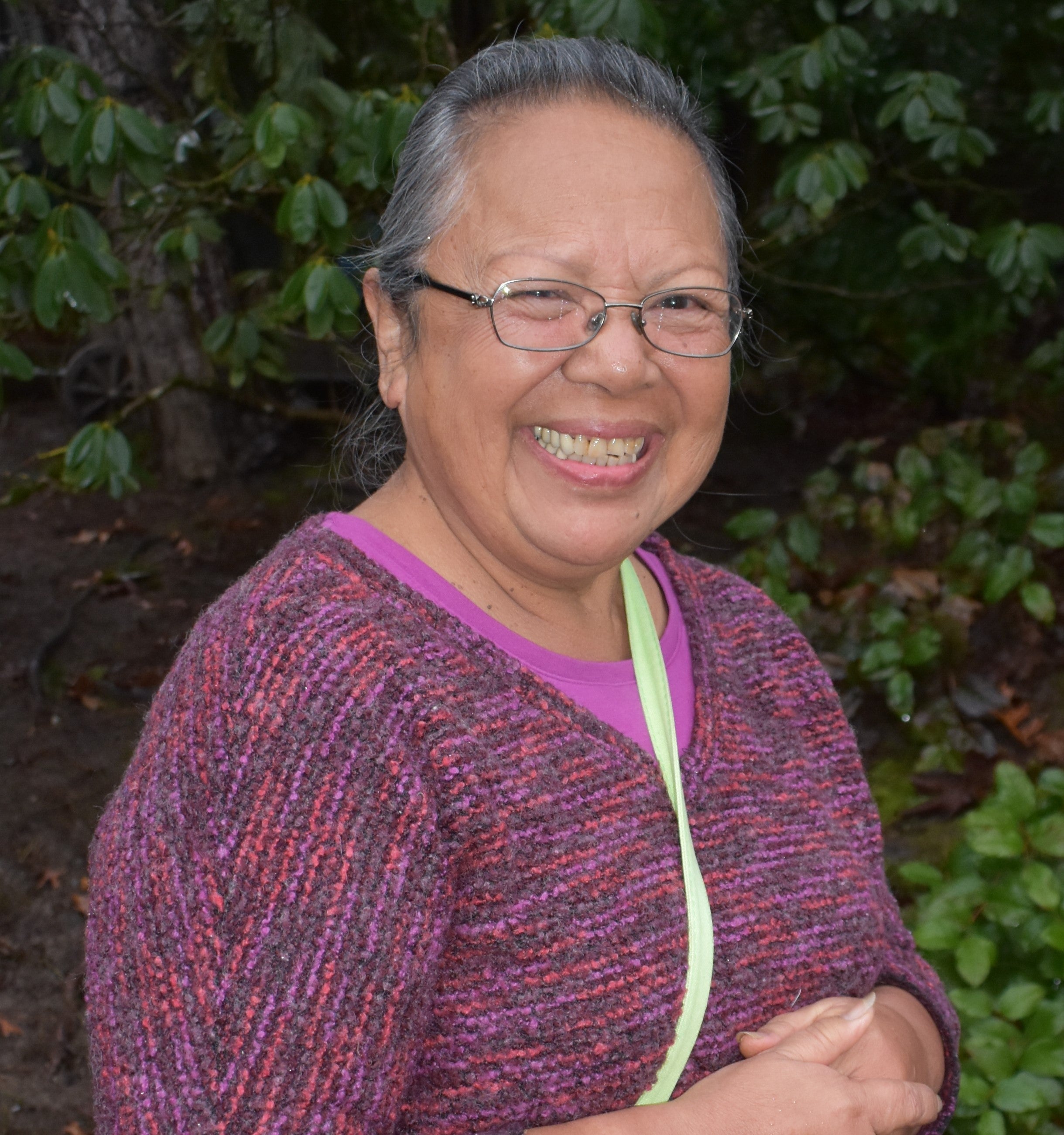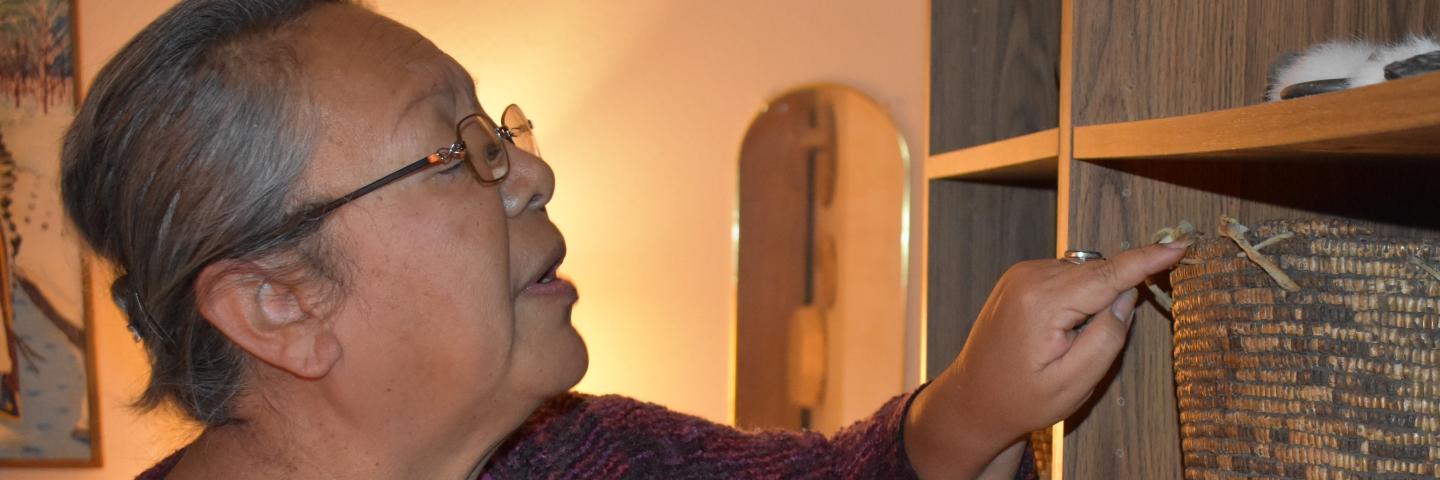 | Traditional Skill/Art Craft: Nez Perce Weaving Years Awarded: 2019 Contact Information: Phone: (503)970-8004 Email: celeste.whitewolf@gmail.com
|
ARTIST BIOGRAPHY
Celeste Whitewolf is a weaver of Nez Perce cemiitx ‘itetpe’s (“Huckleberry Baskets”) and liic kaw (“Huckleberry Hats”). Her maternal elders, members of the Confederated Tribes of Umatilla, were recognized Gatherers in the Nez Perce tradition. On her father's side, Celeste descends from generations of Karuk weavers.
Celeste learned the art of Karuk weaving by attending annual gatherings at tribal headquarters, where local weavers graciously taught her their art. She also studied with the Grand Ronde tribal people through their Lifeways classes in Portland, OR, learning to work with cedar and sedge under the guidance of teacher Greg Archuleta. She learned to weave Cemiitx ‘itetpe’s in a year-long project working with Master Weaver Margaret Matheson, using the baskets handed down from her grandmother as a guide.
Celeste is a member of the Columbia Basin Basketweavers Guild and the Northwest Native American Basketweavers Association (NNABA). Her work has been exhibited in various locations, including the Evergreen College as part of the Teachings of the Tree projects, the yehaw Exhibition at the King Street Station in Seattle, Washington, and the Josephy Arts and Culture Center in Joseph, Oregon. She has also served for four years as an Artist in Residence at the Josephy Arts Center.
APPRENTICE BIOGRAPHY - Brosnan Spencer 2019
Brosnan Spencer is an enrolled tribal member of the Confederated tribes of the Umatilla Indian reservation (C.T.U.I.R.). Brosnan, a homeschool mother and entrepreneur, created her own Massage business in 2016 and is the only practicing Native American to offer massage on her reservation.
Brosnan enjoys weaving, beading, hide tanning, wild tending, and singing. Weaving has been a big teacher in her life. There is so much to learn, gather, and tend that goes into weaving and she uses it as a meditation and a way to let her creativity flow. Weaving deepens Brosnan’s connection to the land and her culture.
Brosnan’s intention is to live her authentic self and to not hold back her power as an indigenous woman. To create, share, learn, be kind, give thanks and lead by example.
Describe your traditional art.
Body
I come from a long line of Karuk weavers. I weave cemiitx ‘itetpe’s (huckleberry baskets) and liic kaws (basket hats) that are traditional to my maternal Cayuse/Nez Perce culture.
How did you come to learn this tradition?
Body
I own two ancient cedar root cemiitx ‘itetpe’s, handed down from my great-grandmother Julia Whitewolf. Using these baskets as a guide, and through a grant from Evergreen College, I completed a year-long project working with Master Weaver Margaret Mathewson, learning how to recreate these ancient baskets.
I have come to learn of the Karuk weaving skills by attending an annual weaving gathering for the past five years held at the tribal headquarters. Many of the local weavers have graciously taught me their art. Since weaving is not part of my maternal cultural history, and the Karuk weaving experience is limited by distance, I began my weaving experience by learning from the Grand Ronde tribal people through their Portland, Oregon Lifeways classes. The primary teacher at these classes is Greg Archuleta. With his assistance, I learned to work primarily with cedar and sedge. I joined the Columbia Basin Basketweavers Guild and the Northwest Native American Basketweavers Association (NNABA). Not limited by a historical tribal weaving experience, I have experimented with a wide variety of materials. I have made cedar hats, roses, headbands, placemats, and a pounded cedar cape. By attending a Nez Perce tribal and NNABA weaving functions, I learned how to complete a corn husk bag and side purse. I do not sell my work, but gift them to family and community members.
Why is this cultural tradition important to your community?
Body
Gathering is traditional to the Eastern Oregon Plateau Tribes’ heritage and cultural practice.A cemiitx ‘itetpe’s is a required tool for gathering huckleberries, which are a mandatory part of the Plateau Tribes’ first foods offering. The huckleberries must be collected in a practical, mobile, lightweight container. Cemiitx ‘itetpe’s baskets are made specially to protect the huckleberries. A belt is attached to the top of the basket so the picker can carry the basket from bush to bush. The basket has hard-slanted sides with a small oval base and large opening. The degree of the slant is purposeful. When made properly, the berries at the bottom of the basket will not be smashed by the berries at the top. The loops at the top of the basket allow us to lay ferns on top of the basket and weave the belt through the loops to make a fern-leaf lid to protect the filled basket.
For special ceremonies such as namings, Root Feast, Salmon Feast, traditional funerals and memorials for deceased family members, the gatherers are usually women descended from elders who were also gatherers. New traditional gatherers must be people of good moral behavior.
Traditionally, to show their status as recognized gatherers, the women wear the liic kaw (basket hat). These ceremonial hats are generally woven using corn husk, bear grass, hemp and yarn materials. The hats are worn when the women are serving the first foods at the ceremonial meals, and while participating in the Longhouse ceremonial activities.
Experience/Honors
Body
Celeste has not received awards, honors or other forms of recognition for her weaving as the “non-Indian” culture would acknowledge. She does not seek such awards for her weaving. She is honored in the traditional way:
When she is sitting in the Longhouse, attending a “powwow” or ceremony or other such Native traditional activity.
When she was asked to be the “Women” speaker at the graveside memorial services for Atwai Carl Sampson, former Walla Walla chief.
When she is asked by Carma Cochran, Lewis and Clark Law School Indian Student Coordinator to say the “Prayer” for law school activities recognizing Indian dignitaries talking at the school.
When she is asked by D’Ana Valenzuela and Sky Beskonechnyy Young to be their recognized elder at their LEAD luncheon.
When she lead the women into a powwow because she was the oldest person in line, and was wearing her buckskin dress.
When she was presented by Bruce Campbell and Melvin Victor McGill a “hand carved and painted” traditional paddle for her work with the Portland All Nations Canoe Family.
Visit OFN's Culture Keepers Roster to learn more about the artist.
Traditional Arts Apprenticeship Program
More OFN programs
OFN main page
